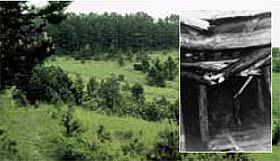The Aarnescht in the past
The “Aarnescht” belongs to the old cultivated landscape of once in the community of Niederanven. Since ever the region has been farmed intensively as well in agriculture as forestry. In the early 20th century grain had been cultivated there and it is said that the oat fields there had to get reduced because its bad quality. Later on the Aarnescht served as pastures.
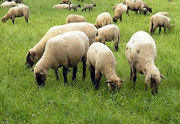 |
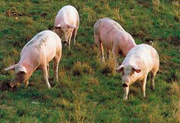 |
| Extensive agriculture had once been run on the Aarnescht (oat fields and pastures). |
|
From 1920 to 1930, the locals from Oberanven lead their pigs on the Aarnescht and a man from Rameldange always came with his goats. In the thirties and forties the cows of the farmers from Oberanven came there to graze. Since about 30 years no agricultural activity is run on the the protected zone of the Aarnescht.
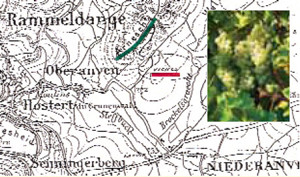
The vineyards are still shown on the “Hansen Map” of 1905.
The “Hansen Map” of the year 1905 even indicates the Aarnescht as being also a ground of vineyard. Small vineyards of about 2ha had been installed and run on the dry south slopes, coddled by the sun.
A small part of the site has also been used for forestry. Hornbeam and oak woods were taken for firewood by the coppice-with-standards system. The old and high oaks were left for a later use in construction. After the deservation of agriculture, European black pines were planted on the fallowed land and their wood had been used later in the mines.
The Aarnescht today and its importance in nature protection
Thanks to an interaction between human intervention and the natural predispositions on the site, a rare and precious biotope could be created (one of the most important on the national level). But that has not always been like this.
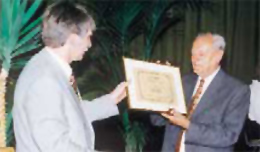
Professor Leopold Reichling, also called “the exploratory of the Aarnescht”, when he received the award “Mérite culturel” by the Municipality of Niederanven.
The professor Leopold Reichling reported that in the early fifties of the 20th” century there were only few rare flora specimens to be found on the Aarnescht. The site only gained of scientific importance in the seventies, when the professors Marie-Josée Wegener and Leopold Reichling published another report about the Aarnescht saying that many rare species of fauna and flora could then be found. The national Administration of Waters and Forests decided hereupon to declare the Aarnescht a protected zone, which had been integrated into the general development map of Niederanven in 1978. In 1986 then the site had been officially declared as being a national Natural Reserve. A formal regulation of the Grand-Duke on this subject had been released on the 1st of February 1988.
Special events on the Aarnescht
Some precise events will always stay in the memory of the locals, so proudly sticking to their Aarnescht. Some tell about little and big fires; another story tells about a deserter, hiding there in the bushes in 1944.

